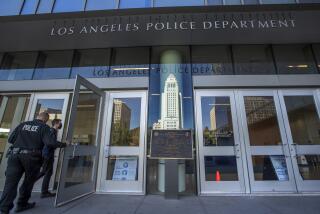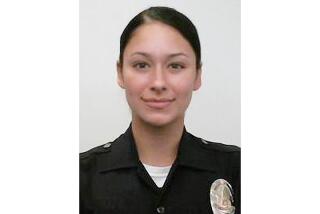O.C. Deputy’s Death a Costly Lesson on Safety
One Orange County sheriff’s deputy was carrying an unauthorized weapon. A second used a loaded pistol during a training exercise. The officers pointed their guns at each other, in violation of the golden rule of safety that most children can recite. And the loaded pistol did not have its safety catch engaged.
The result was the police community’s worst nightmare: one officer killed at the hands of another.
Even though the surviving officer, Deputy Brian P. Scanlan, was effectively cleared this week of criminal wrongdoing, dispelling a cloud that had hovered menacingly over the killing, the death of Deputy Darryn Leroy Robins will long linger in the collective memory of the county’s police departments.
“This will be a topic of discussion at a lot of briefings, a lot of coffee stops and a lot of training sessions,” Orange Police Chief John R. Robertson said the day after the Orange County Grand Jury rejected the recommendation of county prosecutors, and declined to indict Scanlan for involuntary manslaughter. “There are a lot of lessons to be learned here.”
In the 2 1/2 months that have transpired since the fatal shooting--the first accidental death of a deputy during a training exercise in the 105-year history of the Sheriff’s Department--several police agencies around the county have re-examined and re-emphasized their policies regarding firearms and field training.
And now, the Sheriff’s Department itself is considering changing a rule that forbids deputies to carry backup weapons.
Sheriff Brad Gates said in an interview at week’s end that the Scanlan-Robins shooting has brought tension to the department--and emotional upheaval to him personally--that is probably unparalleled in his 33-year career on the force.
“It’s not been an easy roller-coaster ride for us here. We get somewhat healed, and then something else happens,” said Gates, explaining that it has been especially difficult to cope with the shooting because he has received scant information on the district attorney’s investigation.
“Questions are going to be there for the rest of our lives,” Gates said.
“It’s easier to be shot by a bad guy,” the sheriff mused. In that situation, “you’ve given your life trying to accomplish something good, and you’re shot in the line of that duty.
“This is a good person/good person tragedy. There is no bad guy,” he said.
According to the first detailed account of the shooting, released by the Sheriff’s Department on Thursday, Robins and Scanlan--longtime colleagues and buddies outside working hours--were re-enacting a traffic stop in a Lake Forest movie theater parking lot when Robins, mimicking a maneuver he had seen on the street, reached for a .25-caliber automatic he had concealed behind the sun visor of his car, and pointed it at Scanlan.
Startled, Scanlan--who was holding his loaded pistol and was resting his right arm on the patrol car’s roof--stepped back reflexively and accidentally shot Robins in the face.
As Scanlan scurried forward to help his wounded colleague, Robins uttered his last word: “Hospital.” Scanlan rushed him there, but Robins died.
In most Orange County police departments, officers are allowed to carry second or backup weapons. But they must be certified to handle them, have the approval of their supervisor to carry them and, generally, keep the weapons on them.
More and more officers have taken to carrying two weapons in recent years, police leaders around the county said.
“You go to a cocktail party and you listen to the people talk about carrying guns,” said Ronald E. Lowenberg, Huntington Beach’s police chief. “Unfortunately, I think, instead of moving away from the Old West, we’re going back to a situation where people feel it’s necessary to arm themselves. Maybe the police officers just feel it’s necessary to carry additional firepower.”
Irvine Detective Henry Boggs, president of that city’s police union, agreed, calling a second weapon “mandatory in today’s environment.”
But backup weapons are against the rules in the Sheriff’s Department, and carrying an unauthorized weapon in any department can be cause for serious discipline, various chiefs said.
Sheriff Gates said he was unsure whether Robins’ second weapon was even loaded, and whether he was actually carrying the handgun as a backup, or had it in the car for some other reason.
Still, it appears to have cost him his life.
“I think (Scanlan) was just surprised and ‘Boom!’ I’m sure that (Scanlan) was shocked, and I’m sure that led to pulling the trigger,” Robertson said. “We train our officers to react in a split second. If they don’t, it may cost them their lives. Unfortunately, in this case, it cost somebody (else) a life.”
Every veteran officer has haunting memories of close calls or tragic accidents.
On Friday, Placentia Police Chief Manuel Ortega recalled the time he chased a thief in a field as a young officer and how he had his gun drawn, finger on the trigger, when a teen-ager popped up at close range. He still feels lucky he did not shoot reflexively.
Santa Ana Police Chief Paul M. Walters thought back to his days in the Air Force in the 1960s when one officer shot and killed another accidentally.
David L. Snowden, Costa Mesa’s police chief, also recalled a time when a man under his command had his own gun go off, the bullet lodging in his buttocks. “Many of us said, ‘There but for the grace of God go I,’ ” Snowden said. “In our business, we have that opportunity more than anybody in any other profession. We have that ability to have accidents that injure or kill someone.”
Of the Scanlan-Robins tragedy, he added: “This is probably the worst of the worst.”
It has been 2 1/2 months since the shooting, but every briefing at the Sheriff’s Department still includes an added reminder to be vigilant in firearms safety, Gates said. Other departments also responded to Robins’ death by re-emphasizing their safety rules and regulations, issuing fresh memos with points about firearms highlighted, or calling special briefings in response to the shooting.
Because the mistakes resulted from clear policy violations--using a loaded weapon during training, for one--departments have not actually made rule changes in the aftermath. Rather, it has been a case of relearning basic lessons. The hard way.
“You have so many policies in law enforcement. Usually a policy book is three inches thick. It’s important sometimes to remind people what is important,” said Stanley L. Knee, chief of the Garden Grove police force. “Immediately after (the shooting), we ensured that our policies mandated safe training, we ensured that our people understood the policies.”
Added Gates: “I’m sure that all the law enforcement agencies in the area have pulled out their rules. What are we doing? How are we doing it? Let’s make sure we’re doing it properly.”
While police officers were relieved to learn Thursday that Scanlan was not indicted, some were upset to hear that Orange County Dist. Atty. Michael R. Capizzi wanted to prosecute him for involuntary manslaughter. District attorneys and police are normally on the same side in crime-fighting. So when prosecutors investigate officer-involved shootings, tension inevitably results.
“I don’t think there has been an instance when an accidental shooting by a police officer in Orange County has been prosecuted,” said Boggs, the Irvine police union president.
But Garden Grove Sgt. Joe Johnson sees it differently. “The D.A.’s decision sends a message, same as we send to our own,” he said. “You are responsible for your actions.”
Days after the shooting, and again in response to the news that there would be no indictment, local black activists called for further investigation into the incident, questioning whether race may have been a factor. Robins was black; Scanlan is white.
As the African American groups mourned Robins at vigils and held press conferences to criticize the sheriff’s handling of the incident, the schism between police departments and minority communities appears to grow even wider. Not only has the incident led to outrage among civil rights leaders, but their response to it has also further alienated the law enforcement community.
“My biggest problem is . . . these minority groups and their speculation that this was a race-related incident, without any evidence whatsoever,” said Robert MacLeod, general manager of the Orange County Deputy Sheriffs Assn.
“They preferred, they hoped, that there was something racial here, so they could use it for their own purposes,” MacLeod said. “They don’t care about Darryn Robins; they don’t even know him. Yet they stood back and made it harder for the Robins family and every Orange County sheriff’s deputy, and the Scanlan family, by their totally unwarranted insinuations and the allegation that it was racial.”
MacLeod, who heads the 1,300-member union, said the Scanlan-Robins incident has been the topic of conversation at every board meeting--gatherings of two or more deputies--for months.
In other departments, too, the pain lingers, mingled with the trauma from the spate of recent shootings of law enforcement officers in Southern California.
“It seems like lately our flags have been flying at half-mast more often than not, the black bands have been on badges more often than not,” Lowenberg said. “It’s even more disturbing when an unfortunate accident like this occurs, and someone loses their life at the hands of another law enforcement officer.”
Times staff writer Jeff Brazil contributed to this report.
More to Read
Sign up for Essential California
The most important California stories and recommendations in your inbox every morning.
You may occasionally receive promotional content from the Los Angeles Times.









